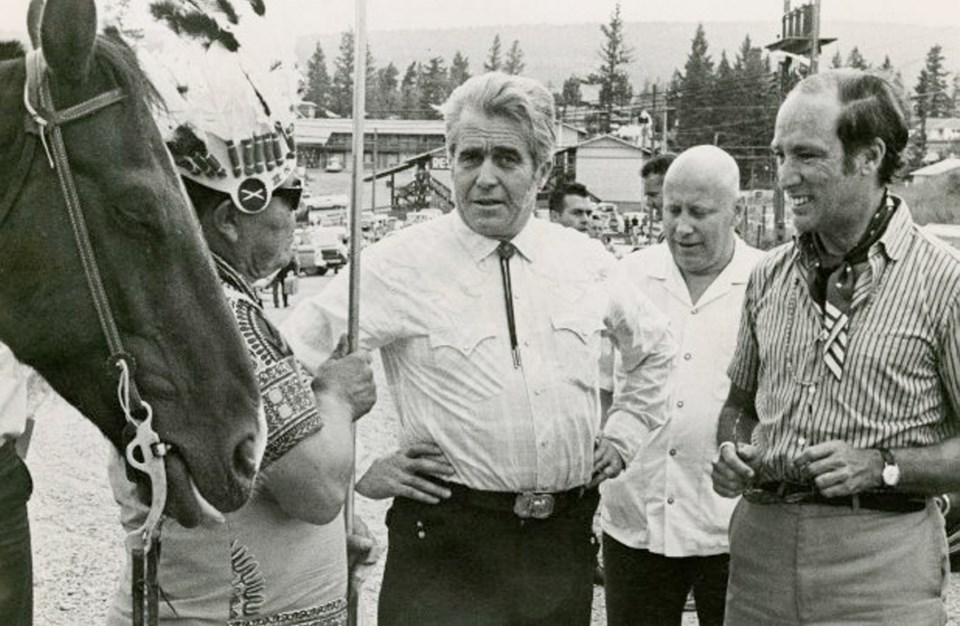Paul St. Pierre was born in Chicago and grew up in Nova Scotia, but he was a true B.C. original.
As a journalist, screenwriter and novelist, St. Pierre spent decades chronicling British Columbia, especially his beloved Cariboo-Chilcotin.
“I found people there more interesting than almost anywhere else,” St. Pierre told Lynne McNamara in a 1988 interview posted on YouTube. “They were sufficiently isolated that their personalities could develop independently of the customs and shibboleths of the rest of the world. It was a place where people had strong characters; they knew who they were.”
The same could be said of Paul St. Pierre, who died Sunday at his home in Fort Langley. He was 90.
With his mutton-chop sideburns and great shock of hair, St. Pierre cut a distinctive figure wherever he went. And he went most everywhere in B.C. in the 1950s, ’60s and ’70s, when he was one of the Vancouver Sun’s most popular writers.
“He’d drive to the end of the road, and then beyond, every road, to see what was there,” said his son Paul St. Pierre Jr.
“Or wasn’t there. So I’ve been (with him) to a lot of mud holes and trackless meadows and wild goose chases and washouts and whatever, just to see what was there, just to stay off the main highways and get out and talk to whoever was at the end of the road.”
The characters he met fuelled his columns.
“He liked to wander around and find stories,” said retired Sun photographer George Diack. “He would go and talk to people, find interesting people and write stories about them. That’s the kind of thing he loved doing.”
In 1960, he turned his stories about the B.C. interior into a CBC-TV series, Cariboo Country. It was cancelled after one season, but came back in 1964 and ran until 1967.
Cariboo Country revolved around a rancher named Smith, who had no first name. St. Pierre also wrote a couple of acclaimed novels featuring the character, Breaking Smith’s Quarter Horse, and Smith and Other Events.
His writing was a huge influence on many B.C. writers, including former Sun columnist Jamie Lamb.
“To me, Smith and Other Events is right up there with (Stephen Leacock’s) Sunshine Sketches of a Little Town as the great Canadian book,” said Lamb.
“It’s entertaining, and it’s a completely different take on everything from First Nations to ranchers to everything else. There’s a chapter called How to Run The Country which is as good a political primer as any 10 text books.”
Indeed, in 1968 St. Pierre was elected as a federal Liberal MP for Coast-Chilcotin as part of the Pierre Trudeau landslide. But his son doesn’t think his temperament really suited politics.
“If he had stayed in politics, I don’t believe he would have been successful, because he was never willing to accommodate anybody,” said St. Pierre Jr. “He basically felt if he told you what was wrong and you had common sense, then you’d do it his way.”
St. Pierre grew up in Dartmouth, Nova Scotia, where he landed his first newspaper gig at the Dartmouth Weekly in 1940. He joined the Royal Canadian Air Froce in 1941, but it was discovered he had a heart condition from a bout of rheumatic fever and he was pensioned out of the service.
In 1945, he came west to work for the Columbian newspaperin New Westminster. He moved to the Vancouver News-Herald in 1946, and a year later went to the Sun.
He was a general news reporter for several years before he became a columnist. In a 1960 bio, he wrote that he was a “roving reporter” working on the “re-discovery of British Columbia.”
“It is an assignment more or less unique in the newspaper business,” wrote St. Pierre, referring to himself in the third person. “He thinks up his own jobs, draws out money (and) takes off, the office seldom knowing where he is, or how to get ahold of him.”
Much of the time he was at his Big Creek cabin in the Chilcotin.
“He leased some land on a remote lake for 25 years, and built a log cabin there,” said St. Pierre Jr. “We would spend summers there, and he would visit at other times as well. He would do a lot of driving around, all the ranches in the neighbourhood and all over the Chilcotin, collecting his stories.
“When the lease expired he wasn’t going to let the government, ‘the goddamn government,’ get their hands on that cabin. So he literally had it dismantled log-by-log and moved 25 miles to a local ranch. He gave it to a rancher who ran trail rides, and he used it as a guest cabin.”
He also loved Mexico, wintering for three decades in Teacapan, a small village two hours south of Mazatlan. Naturally, he drove there rather than fly, which provided more fodder for his stories.
St. Pierre was married and divorced twice. He had three children with his first wife Carol (Paul, Michelle and Suzanne) and adopted a fourth (Yesica) in Mexico.
He was in good health until the past few months, when he got pneumonia and was hospitalized. He likened the hospital to being in prison, and convinced his children to bring him home. They did, and his health got better for a couple of months before declining in the past week. He died Sunday afternoon, with his family at his side.



